1 jour
Voyage spécifique
20 people
Arabe, Anglais, Français
La Route Touristique des Ponts
Centre Ville de Constantine
La mère de la métropole, la ville du vieux rocher, la ville de la science et des savants, la ville des ponts suspendus. Oui, c'est la ville de Constantine qui a tant donné à l'histoire depuis l'Antiquité. Peut-être que le nom de la ville des ponts suspendus est venu en rapport avec le recensement de ses ponts, dont chacun raconte une histoire qui plonge son visiteur dans l'histoire et la civilisation, à l'instar des ponts de Sidi M'cid, de Mellah Souleiman, du pont romain, ottoman, de celui de Bab El Kantara et du pont de Saleh Bey. A travers ces ponts, tous aussi prestigieux les uns que les autres, nous vous ferons découvrir cette ville à l'histoire millénaire. C'est d'ailleurs pour cette raison qu'on lui a donné le nom de ponts suspendus :
After leaving on foot from the city center from the November 1st Square, we head towards a masterpiece of architecture, The Sidi Rached Bridge: Which connects the two banks of the city above the Rhummel, overlooks the old district called La Souika overlooking the tomb of Sidi Rched. This bridge is considered the twin of the Adolphe bridge in Luxembourg. It is 447 meters long, 12 meters wide and 105 meters high, supported by 27 pillars built in the shape of arches, the largest of which is 70 meters in diameter. After the Sidi Rached bridge, we head not far to the Devil’s Bridge. What visitors fear because of the strangeness of its name and the inviolability of its location. Some consider it a Roman installation, while others consider it an Ottoman bridge, the height of which does not exceed 66 meters. It is the last stage where the tourist route stops, starting from the bridge of the falls. echoes echoed in the distance. Some explain the origin of the name to certain European Christian legends that the French launched on the site.
Bab El Kantara Bridge: The first bridges in the city of Constantine and one of its main entrances, it is considered one of the most important testimonies to the ancient history of the city and the civilizations that succeeded it. The bridge dates back to Roman times. It was built to settle the issue of water distribution in the city. It was destroyed between the Roman and Ottoman periods. Salah bey decided in 1792 to rebuild it The French decided in 1857 to build another work just above and this is how Bab El Kantara was able to preserve its distinctive form. The attention of the passer-by just next door is retained by its unique architecture, its well-cut blue stones adorning its large arch and its arched shape linking the two parts of the city over a distance of 60 m. and a width of 7.5 m its height of 65 meters!
Pont Mellah Suleiman : les habitants l’appellent le pont Sansor (ce qui signifie le pont levant) et il est également appelé le pont fantôme, en raison d’histoires suggérant qu’il s’agit d’un pont hanté par les fantômes de personnes qui s’y sont suicidées. En l’empruntant on a le sentiment de balancer de droite à gauche. Ses escaliers en colimaçon creusés dans la roche sur 05 étages l’embrassent et son ascenseur au bord du pont peut accueillir 10 personnes et pour quelques dinars seulement vous déposera de l’autre côté du centre ville et dès les portes de ce dernier ouvrira, vous vous retrouverez à l’entrée des quartiers et rues les plus prestigieux de la ville.
Pont Sidi M’Cid : On l’appelle aussi le pont suspendu, ou comme l’appellent les visiteurs, l’arche de corde. Il est soutenu par des piliers en contrebas, longs de 168 mètres et larges de 05 mètres, et sa hauteur est estimée à 175 mètres.
Le Pont des Cascades : Le Pont des Cascades est situé au pied du pont Sidi M’Cid entre les gorges du Rhumel. Le pont a été construit en 1928 et constitue l’un des chemins les plus importants utilisés par les amateurs de baignade, les pionniers de l’ancienne piscine de Sidi M’Cid, et par les amoureux de la nature curieux d’explorer les profondeurs de l’ancienne cité du Rocher, comme l’eau du Rhumel traverse entre les 05 arches du pont pour dévaler une pente formant une cascade qui dresse un splendide tableau naturel. Le Pont des Cascades est la dernière station de la route touristique du Rhumel.
Pont Bey Salah :
On l’appelle aussi le pont géant. C’est la fierté de la ville d’être le plus grand de ses ponts à câbles. L’équilibre du pont est assuré par deux tours principales d’une hauteur de 130 mètres au dessus du sol (la vallée) et six petites tours pour supporter et répartir les charges, tandis que sa largeur est de 27,34 mètres, sa construction a débuté en 2010 et les travaux ont été achevé en 2014. Il porte le nom de Salah Bey, l’un des Beyliks du Beylik oriental (1771-1792) et l’un des symboles historiques les plus importants du Beylik de Constantine. La période de son passage au beylicate fut la plus prospère tant sur le plan économique que social. La visite se termine par ce dernier pont, et le visiteur peut découvrir d’autres ponts de la ville.
After breakfast, you will meet your guide in the hotel's lobby at 9h00 Departure from the city center
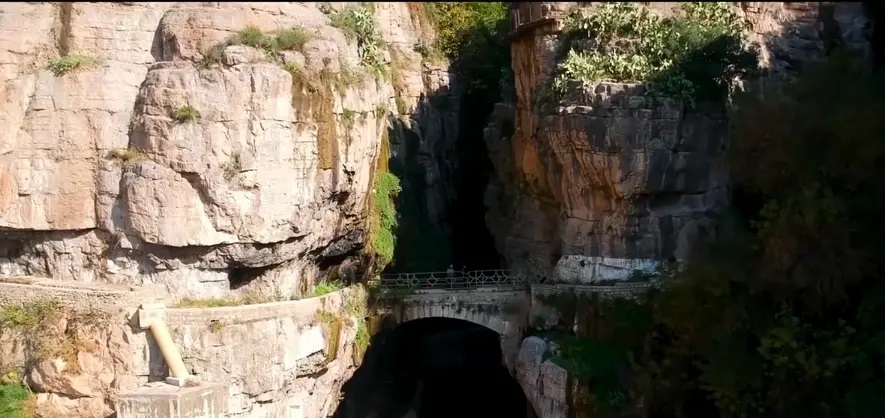
Devil's bridge Devil's Bridge: It is located under the Sidi Rached bridge. It is a bridge that visitors fear because of the strangeness of its name and the inviolability of its location. Some consider it a Roman installation, while others consider it an Ottoman bridge. Its height does not exceed 66 metres and forms a link between the two banks of the ancient rock. It is also an estuary for the waters of the Rummel and the Oued Boumerzouk, hence the name given to the bridge is “The Devil”. These noises are nothing more than the result of the waterfalls of the aforementioned Oueds, which resonate because of the caves surrounding the bridge and emanating from inside the rock. The inhabitants of the town centre, whose houses overlook the abyss, hear terrifying roars at night that make their bodies shudder.
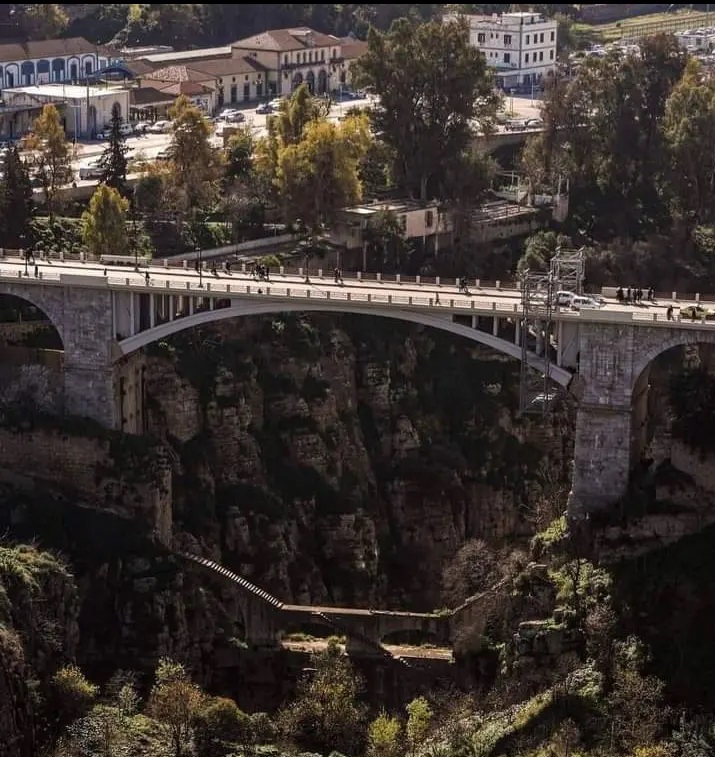
Visit of the bab el kantara bridge El-Kantara has a rich and diverse heritage namely the Dachra Dhahraouia (red village) and its Casbah, the Roman remains as well as the open air museum. The Dachra (village) is an open-air museum. Its narrow, often covered alleys and its typical dwellings with a practical structure withstand the heat of the summer and the harshness of the winter. It is located in the north-western part of the city. These traditional dwellings are built in “toub” (clay bricks). these type of bricks are made from a uniform pattern of earth by means of a wooden mould. Their roofs are terrace-shaped and covered with transversely cut palm trunks, palm leaves, earth and often wicker.
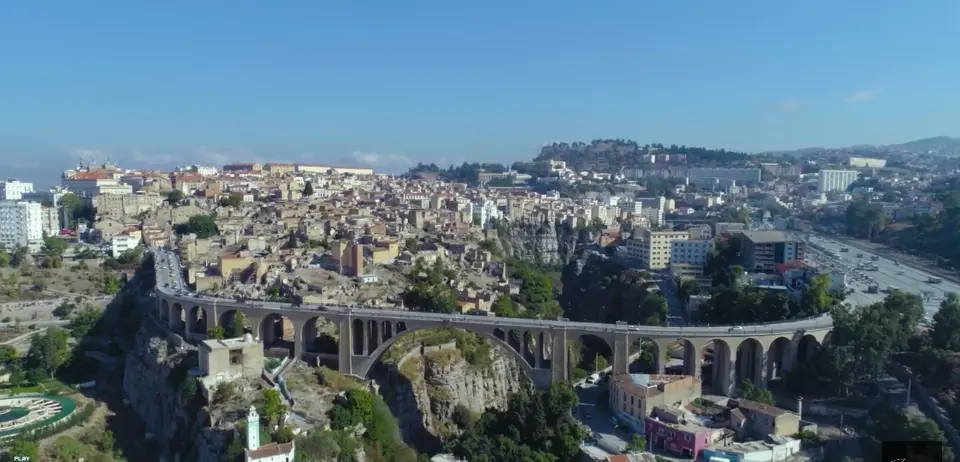
Sidi Rached Bridge Sidi Rached Bridge: Among the bridges from which Constantine is derived its ancient name “The City of Suspended Bridges”. This architectural masterpiece joins the two parts of Constantine City, crossing the Rhumel Wadi. It lies in the Souika neighbourhood, not far from Constantine's city centre, just above the tomb of Sidi Rashed. The bridge is a twin version of the Adolf Bridge in Luxembourg. It was constructed by Algerian hands and overseen by the French engineer “Auban Giraud” with the help of his fellow French engineer “Paul Sigourney” between 1907 and 1912. It was constructed on large hand-polished stones brought from the Catalan region of Ibiza in Spain, and it was classified for several decades as the largest stone bridge in the world, as it measures 447 meters long, 12 meters wide and 105 meters high, is sustained by 27 pillars shaped like arches of which the largest measures 70 meters in diameter.
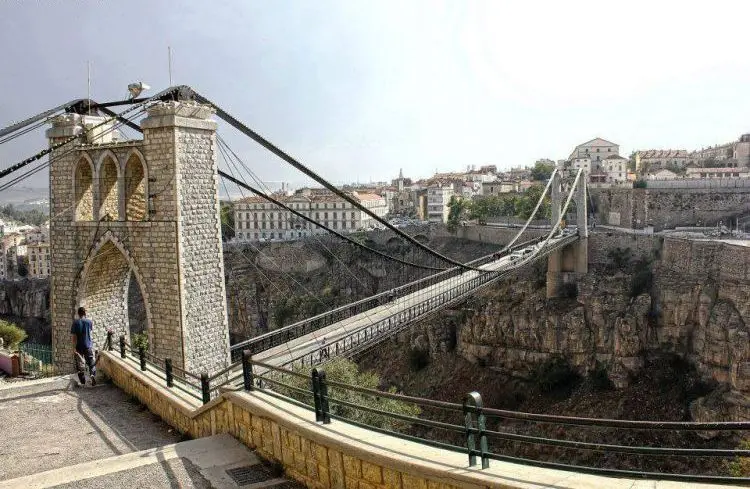
Yugoslavia Street, Constantine, Constantine. Bridge of Sidi M'cid: Also known as the suspension bridge. It links the Casbah and the University Hospital. By crossing it, one feels as if hanging in the air. Actually, it waddles with the slightest breeze. In 1903, the mayor of the city, Emile Morinaud, conceived the idea of building it. At first, the project could not be realized because of some technical issues, but it was resurrected by the engineers Rabi and Soilar in 1909 with the assistance of the French engineer Ferdinand Arnodin (the most famous designer of metal suspension bridges in Europe) and opened to the public in 1912. The pillars beneath measure 168 meters long, 05 meters wide and 175 meters high.
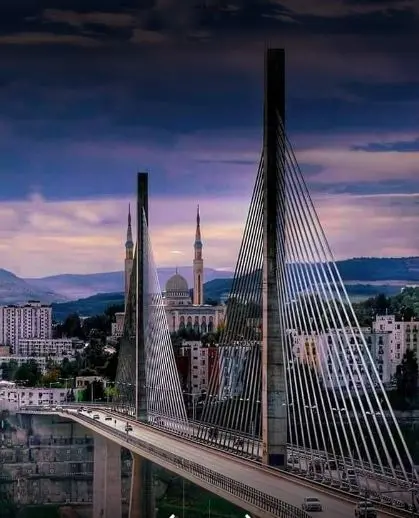
The bridge is also known as the Bridge of Giants or the Bridge of Independence. It makes the pride of the city by being the largest of its suspension bridges. Its length is 1,119 meters (749 meters of main bridge and 370 meters of subsidiary bridges) which links the two banks of the Rhumel wadi from the United Nations square at the western end to the Mansoura, located on the eastern end in the city centre at an altitude of 60 meters above the wadi. It is embedded in a total structure of 4,300 meters in length among “connections” and “entries”. Its equilibrium is sustained by two main towers with a height of 130 meters above ground level (the wadi) as well as 6 small towers to support and redistribute the loads, whereas its width is 27.34 meters. The bridge includes two lanes opened to the automobile traffic and two pedestrian lanes on each side (tourists). The bridge crossing the Rummel Wadi is distinguished by its guaranteed maximum safety and security conditions by means of foundations and columns adapted to the solid nature of the soil, and exit and entrance supports designed to withstand earthquakes as well as winds. Its construction was launched in 2010 under the supervision of the Brazilian company Andrade Gutierrez, financed by Algeria, inaugurated in 2014 on Knowledge Day, 16 April 2014. It became operational on 26 July 2014. It was named after Salah Bey, one of the beys of the Eastern Beylik (1771-1792) and a major historical symbol of the city of Constantine, which witnessed great economic and social prosperity during his reign.

The Waterfalls Bridge is situated at the bottom of the Sidi M'Sid bridge between The Rhumel gorges. The bridge was constructed in 1928 and is one of the most important ways used by bathing enthusiasts, pioneers of the old Sidi M' Sid swimming pool, and by nature lovers curious to explore the depths of the ancient city of the Rock, as the water of the Rhumel crosses between the 05 arches of the bridge to flow down a slope forming a waterfall that paints a splendid natural picture. The Waterfalls Bridge is the last station on the Rhumel tourist route.
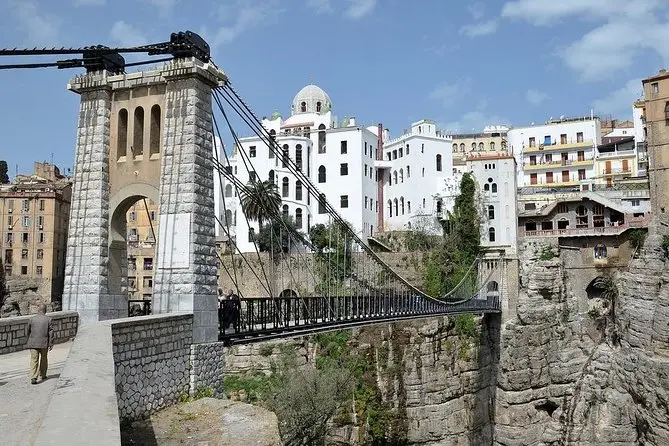
Mellah Slimane Bridge: The inhabitants of the city call it the Sansor Bridge (i.e. the lift) or the ghost bridge, because of the stories about the fact that it is inhabited only by the ghosts of the people who throw themselves into it. When you walk across it, you feel as if you are swinging left and right. In the beginning it was called "Perigo Corridor". At independence it was named after the martyr Rashid El-Halawani, known as Mellah Slimane. The bridge is a miniature model of the Sidi M'Sid bridge, it was built by the French engineer Ferdinand Arnodin between 1917 and 1925. It was opened to the public on 12 April of the same year. Unlike the rest of the city's bridges, the Mellah Slimane Bridge is the only bridge for pedestrians. It is 125 metres long. It connects Larbi Ben M'hidi Street to Romania Street and the station to Bab Al Qantara. It is 2.5 metres wide and 130 metres high. Its spiral staircase cuts through the ancient rock on five floors. Its lift can accommodate 10 people. For only a few dinars you can go to the other side of the city centre. Indeed, as soon as the lift doors open, you will find yourself at the entrance to the most prestigious districts and streets.
Back to the city center to have lunch in a traditional restaurant
Leave a review